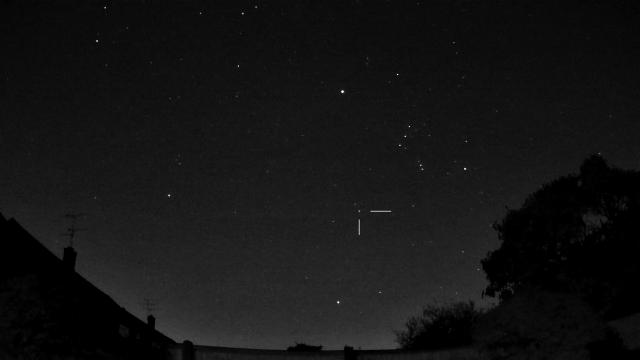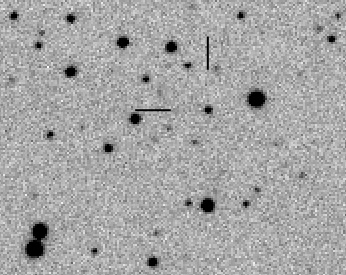Forum Replies Created
-
AuthorPosts
-
 Nick JamesParticipant
Nick JamesParticipantJust for the record your attachment is a doctored version of the Time cover. The original is here. Whatever your views on Elon Musk you should have pointed that out. Twitter is not an ideal primary source for much.
 Nick JamesParticipant
Nick JamesParticipantThanks all for the positive Sky Notes comments. I do appreciate having the opportunity to show some of the excellent work that our members do.
Oddly enough I am seldom referred to as a gentleman…
 Nick JamesParticipant
Nick JamesParticipantThe JBAA is one of the few journals/periodicals that I continue to get as a physical thing. I’ve been a member of the BAA since 1974 and my run of Journals goes back getting on for 50 years (scary) but still only takes up a couple of metres of shelf space so storage isn’t really an issue. A bit like Jeremy I find that I don’t read digital copy in the same way as physical, its much more a quick scan then store it on the computer to look at another day. I tend to embrace new technology but reading for pleasure is still definitely physical books for me and I feel the same way about the Journal.
As Dominic says, you have access to the electronic Journal now so can try it and see how it works out.
 Nick JamesParticipant
Nick JamesParticipant Nick JamesParticipant
Nick JamesParticipantJust search for SOLO on JPL Horizons. We’ll get a good view of it outbound on the evening of Nov 27.
 Nick JamesParticipant
Nick JamesParticipantThat looks like a very nice setup. I couldn’t find it stated explicitly but I think your 60MP sensor is an IMX455. Combining the wide field of that system with automated plate solving and photometry would make it very powerful. Adding moving object detection and astrometry would be even better.
Are you using ACP for scheduling?
 Nick JamesParticipant
Nick JamesParticipantHi Simon, It’s not an observing session but we do have a meeting coming up in Leeds next April. Hope to see you there.
 Nick JamesParticipant
Nick JamesParticipantThanks. That’s an interesting paper. Definitely worth a read.
 Nick JamesParticipant
Nick JamesParticipantThe formation of dust is the usual reason for these sudden dips, and that is consistent with the reddening as shown in the recent photometry, but what about the big humps when it was bright? Is that dust related too or is it an actual brightening of the disc? V1405 Cas has these humps too whereas other novae (V1674 Her for instance) don’t.
Novae are such fascinating things!
4 November 2021 at 6:30 pm in reply to: Flaring of synchronous satellites from Kelling Heath #584887 Nick JamesParticipant
Nick JamesParticipantI suspect that this particular flare was caused by DirecTV 7S. It was boosted to the graveyard orbit at the start of 2021 (see here) which is why it is around 370km higher than the other two. It would have been passivated and would not be under control which would explain the odd geometry for this glint.
3 November 2021 at 7:55 pm in reply to: Flaring of synchronous satellites from Kelling Heath #584883 Nick JamesParticipant
Nick JamesParticipantHere is what one of those GEO flares looks like in real time. The attached is a still from a meteor camera video which you can see here. The video starts at 2021-11-03 01:09:45 UTC and the flare reaches around 2nd mag at 01:09:56 and lasts for around 15s. The potential candidates within 0.1 deg of the estimated position are:
2021-11-03 01:09:56.000000 UTC TOPO 28238 143.17 24.40 0.07 39494.87 -0.009 DIRECTV 7S
2021-11-03 01:09:56.000000 UTC TOPO 38741 143.07 24.34 0.07 39129.06 -0.000 HYLAS 2
2021-11-03 01:09:56.000000 UTC TOPO 47306 143.17 24.36 0.08 39122.74 0.000 TURKSAT 5AThe solar phase angle at the time of this flare was 125 deg so nowhere near opposition.
 31 October 2021 at 5:36 pm in reply to: Flaring of synchronous satellites from Kelling Heath #584877
31 October 2021 at 5:36 pm in reply to: Flaring of synchronous satellites from Kelling Heath #584877 Nick JamesParticipant
Nick JamesParticipantI don’t know whether there is a website which allows you to search for satellites which are in a particular direction at a given time but I computed these directly using TLEs downloaded from here.
 Nick JamesParticipant
Nick JamesParticipantThanks for the alert David. Fingers crossed for clear skies and an active comet!
30 October 2021 at 11:22 pm in reply to: Flaring of synchronous satellites from Kelling Heath #584874 Nick JamesParticipant
Nick JamesParticipantThat is a very interesting video. I’ve estimated the time of the brightest one as 2021-10-11 00:26 and its position as azimuth 177, alt 29. If you search within 2 deg of that for Kelling you get this list of satellites (This is a bit of a mess but I can’t attach a text file since it is not one of the permitted file types:
UTC ID Az Alt Ofs Rg (km) RR (km/s)
===========================================================================================================
2021-10-11 00:26:00.000000 UTC TOPO 24748 175.99 28.87 1.16 39039.51 -0.070 DIRECTV 6 (TEMPO 2)
2021-10-11 00:26:00.000000 UTC TOPO 32299 175.37 29.43 1.91 38664.80 -0.000 ASTRA 4A (SIRIUS 4)
2021-10-11 00:26:00.000000 UTC TOPO 33414 175.84 28.30 1.50 39268.93 0.004 VENESAT-1
2021-10-11 00:26:00.000000 UTC TOPO 36831 177.75 29.53 1.01 38670.19 0.000 RASCOM QAF 1R
2021-10-11 00:26:00.000000 UTC TOPO 39773 177.53 29.57 0.84 38665.08 -0.001 EUTE 3BMy guess is that the bright one is Eutelsat 3B. It has large solar panels (around 70 m^2) and could certainly flare to negative magnitudes if the geometry was right.
26 October 2021 at 7:44 am in reply to: Flaring of synchronous satellites from Kelling Heath #584849 Nick JamesParticipant
Nick JamesParticipantIf you do the calculations it is not that surprising if it is a specular reflection from the solar panels. Around opposition these are pointing straight back at us and they are quite large. A quick order of magnitude calculation follows. Please check!
The sun has an apparent area of around 1E-4 rad^2. A 1m^2 mirror at 40,000 km is around 1E-15 rad^2. Assuming the mirror is a perfect reflector it will have the same surface brightness as the sun so will be 2.5 log10(1E-11) fainter so around 28 mags. The sun is mag -27 so the 1m^2 mirror in GEO could be around mag 1. GEO satellites have solar arrays of 50m^2 or more so a bright NE glint is certainly possible.
 Nick JamesParticipant
Nick JamesParticipantA lot of that is down to the IoP’s AV technician who did a fantastic job supporting us before and during the meeting.
 Nick JamesParticipant
Nick JamesParticipantLivestream is here: https://www.youtube.com/watch?v=pYFNWAlu6uw
 Nick JamesParticipant
Nick JamesParticipantDavid – That is a really interesting story. V476 Cyg is sitting at around 18.0 tonight. I think you’d need a pretty big telescope and dark skies to get the shell.

 Nick JamesParticipant
Nick JamesParticipantIt looks to be around 13.7 tonight.

 Nick JamesParticipant
Nick JamesParticipantIt is certainly dropping quickly. I get 17.32 unfiltered tonight (2021-10-10 21:47:18).
-
AuthorPosts
